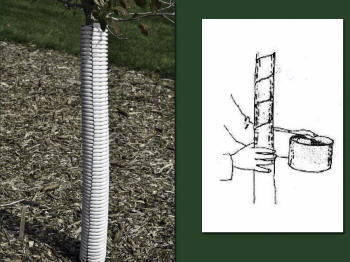It is important to protect the trunks
of young, tender trees from damage. The most common way they
are hurt is by equipment such as lawn mowers or weed whips
banging into the bark. This opens a wound which is almost
always attacked by a disease called a
canker which is
basically an open wound in the bark. A canker does not kill
the tree but will make it less vigorous over time and
shorten its long-term survival. Plus it is an ugly scar to
see.
Another major cause of cankers on a tree would be a
condition called sunscald or winter cracks. These wounds
occur when the smooth, dark colored bark of many species of
trees is exposed to the winter sun on a very cold day. The
sun warms the bark enough to cause it to
 expand but the wood
below is frozen solid and does not move. This results in a
split in the bark, often (but not always) on the south or
southwest side of the tree. Usually, a canker forms on these
wounds.
expand but the wood
below is frozen solid and does not move. This results in a
split in the bark, often (but not always) on the south or
southwest side of the tree. Usually, a canker forms on these
wounds.
To prevent winter cracks, it is often recommended that the
trunk of young, smooth-barked trees be protected. This can
be done with either a plastic sleeve that is white and
reflects the sunlight or a paper wrap that will moderate the
sun's impact.
As with
staking a tree, the key to tree wraps is that they
are a TEMPORARY arrangement. You need to keep an eye on the
wraps to be sure that they are not becoming too tight as the
trunk of the tree grows in girth each year. If left on too
many years, tree wraps can begin to girdle the tree by
growing into the bark and cutting off the vital
cambium
layer. So, only leave such wraps on for a few seasons. Once
the tree bark becomes rough surfaced and "mature", the tree
wrap should be removed.
Tree wraps are often also recommended
for control of mouse damage. This is generally more of a
problem in fruit orchards where mice will sometimes chew the
tender young bark of fruit trees as a food source during the
winter. Such damage is usually not a significant problem in
home landscapes on other types of trees.



